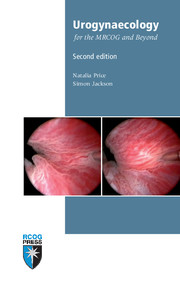Book contents
- Frontmatter
- Contents
- Preface
- Abbreviations
- 1 Applied anatomy and physiology of the lower urinary tract
- 2 Definition and prevalence of urinary incontinence
- 3 Initial assessment of lower urinary tract symptoms
- 4 Further investigation of lower urinary tract symptoms
- 5 Management of stress urinary incontinence
- 6 Management of overactive bladder syndrome
- 7 Recurrent urinary tract infection
- 8 Haematuria
- 9 Painful bladder syndrome and interstitial cystitis
- 10 Pregnancy and the renal tract
- 11 Ageing and urogenital symptoms
- 12 Fistulae and urinary tract injuries
- 13 Pelvic organ prolapse
- 14 Colorectal disorders
- 15 Obstetric anal sphincter injuries
- Index
15 - Obstetric anal sphincter injuries
Published online by Cambridge University Press: 05 July 2014
- Frontmatter
- Contents
- Preface
- Abbreviations
- 1 Applied anatomy and physiology of the lower urinary tract
- 2 Definition and prevalence of urinary incontinence
- 3 Initial assessment of lower urinary tract symptoms
- 4 Further investigation of lower urinary tract symptoms
- 5 Management of stress urinary incontinence
- 6 Management of overactive bladder syndrome
- 7 Recurrent urinary tract infection
- 8 Haematuria
- 9 Painful bladder syndrome and interstitial cystitis
- 10 Pregnancy and the renal tract
- 11 Ageing and urogenital symptoms
- 12 Fistulae and urinary tract injuries
- 13 Pelvic organ prolapse
- 14 Colorectal disorders
- 15 Obstetric anal sphincter injuries
- Index
Summary
Definition and prevalence
The overall risk of obstetric anal sphincter injury is 1% of all vaginal deliveries. Severe perineal tears that involve the anal sphincter complex and/or the anal epithelium (obstetric anal sphincter injury) are identified in 0.6–9.0% of vaginal deliveries where mediolateral episiotomy is performed. However, since the introduction of endoanal ultrasound, sonographic abnormalities of the anal sphincter anatomy have been identified in up to 36% of women after vaginal delivery, in prospective studies.
With increased awareness and training, there appears to be an increase in detection of anal sphincter injury. Obstetricians who are appropriately trained are more likely to provide a consistent high standard of anal sphincter repair and contribute to reducing the extent of morbidity and litigation associated with anal sphincter injury.
Obstetric anal sphincter injury encompasses both third- and fourth-degree perineal tears. A third-degree perineal tear is defined as a partial or complete disruption of the anal sphincter muscles, which may involve either or both the external (EAS) and internal anal sphincter (IAS) muscles. If there is any doubt about the grade of third-degree tear, it is advisable to classify it to the higher degree rather than lower degree (see box below). A fourth-degree tear is defined as a disruption of the anal sphincter muscles with a breach of the rectal mucosa. If the tear involves only anal mucosa with intact anal sphincter complex (buttonhole tear), this has to be documented as a separate entity. If not recognised and repaired, this type of a tear may cause anovaginal fistulae.
The following classification, described by Sultan, has been adopted by the International Consultation on Incontinence and the RCOG.
- Type
- Chapter
- Information
- Urogynaecology for the MRCOG and Beyond , pp. 131 - 138Publisher: Cambridge University PressPrint publication year: 2012

